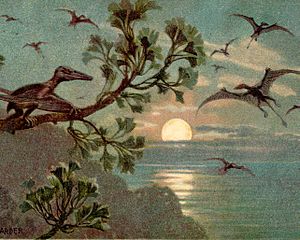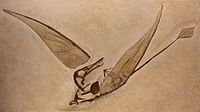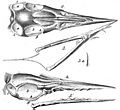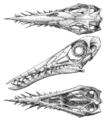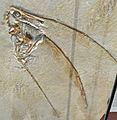Rhamphorhynchus facts for kids
Quick facts for kids RhamphorhynchusTemporal range: Upper Jurassic 150–148 mya
|
|
|---|---|
| Scientific classification | |
| Kingdom: | |
| Phylum: | |
| Class: | |
| Order: | |
| Suborder: |
Rhamphorhynchoidea
|
| Family: |
Rhamphorhynchidae
|
| Genus: |
Rhamphorhynchus
|
Rhamphorhynchus (say "RAM-fo-RING-kus") was a type of flying reptile called a pterosaur. It lived during the Upper Jurassic period, about 150 to 148 million years ago. This amazing creature is one of the most famous long-tailed pterosaurs.
Rhamphorhynchus had a very long tail. This tail was made stiff by special ligaments. At the very end of its tail was a small, diamond-shaped flap. This flap worked like a rudder on a boat, helping the pterosaur stay steady and stable while it flew through the air.
Its mouth was full of needle-like teeth that pointed forward. The tip of its jaw was curved and sharp, like a beak, but it didn't have teeth there. Rhamphorhynchus mostly ate fish and insects.
Like other pterosaurs, its body was covered in hair-like fuzz. This suggests that Rhamphorhynchus was warm-blooded, just like birds and bats. Being warm-blooded means an animal can control its body temperature. This is important for animals that fly a lot, as flying takes a lot of energy.
Rhamphorhynchus was a very successful animal. Many fossils of this pterosaur have been found in the Solnhofen Limestone beds in Bavaria, Germany. These are the same famous rocks where the early bird Archaeopteryx was also discovered.
What are Rhamphorhynchoids?
This group of early pterosaurs lived from the Upper Triassic period until the end of the Jurassic. When we first find their fossils, there are already three main families. This tells us that they had been evolving for some time before we see them in the fossil record.
The three main types in this group are Rhamphorhynchus, Dimorphodon, and Eudimorphodon. Rhamphorhynchoids were the first kind of pterosaurs. Later, a different group of pterosaurs with shorter tails, called Pterodactyloids (like Pterodactylus), became more common. Both types of pterosaurs lived at the same time during the Upper Jurassic.
Rhamphorhynchoids always had long tails. These tails were made stiff by rod-like bony structures, keeping them straight. This design meant they had very stable flight. This means they flew in a steady, straight line and didn't dart around much. We see similar stable flight in early birds like Archaeopteryx, early bats, and even insects like dragonflies.
Think of it like airplanes. Early planes were designed to be very stable, and so are large passenger airliners today. But fighter planes are built to be less stable so they can quickly change direction. This needs very fast reactions, often helped by computers.
It takes more "brainpower" to control something that is unstable than something that is stable. The same idea applies to pterosaurs, birds, and bats. Early flying animals were more stable, often having long tails or (for insects) long bodies. This helped them stay on course while flying.
All pterosaurs in the Rhamphorhynchoidea group had teeth. This group died out at the end of the Jurassic period. This was a time when a small extinction event happened.
How Rhamphorhynchoids are Grouped
Scientists group animals to understand how they are related. Here's a simple way to classify pterosaurs:
- Pterosauria (all pterosaurs)
- Rhamphorhynchoidea (the long-tailed group)
- Dimorphodontidae
- Anurognathidae
- Rhamphorhynchidae
- Scaphognathinae
- Rhamphorynchinae
- Pterodactyloidea (the short-tailed group)
- Rhamphorhynchoidea (the long-tailed group)
Images for kids
See also
 In Spanish: Rhamphorhynchus para niños
In Spanish: Rhamphorhynchus para niños


